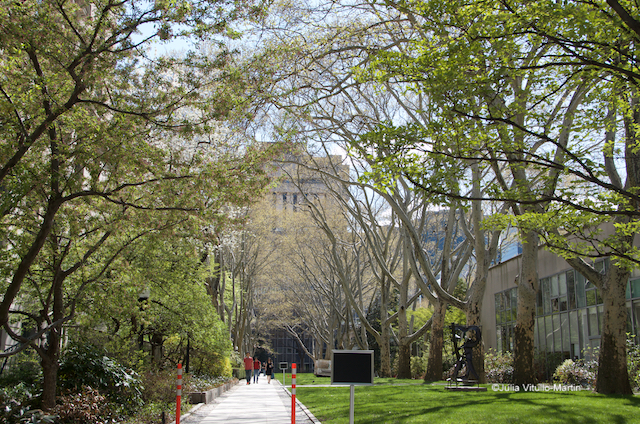
Dan Kiley is the most eminent landscape architect you’ve never heard of—a “seminal landscape architect,” said the New York Times in its 2004 obituary, “who combined modernist functionalism with classical design principles in more than 1,000 projects.”
Or, as the Los-Angeles based architect Harry Wolf once commented, “There are plenty of good landscape architects. But there’s only one Dan Kiley, as there was only one Le Nôtre.”
He worked with the 20th century’s architectural giants—Louis Kahn, I. M. Pei, and especially Eero Saarinen. Yet as Untapped Cities has observed before, neither Saarinen’s nor Kiley’s work is secure. Demolition, insensitive renovations, neglect, and misunderstanding have undermined their legacies.
Now the Washington DC-based Cultural Landscape Foundation has mounted an exhibit at the Center for Architecture that fills in some gaps for New Yorkers. The Landscape Architecture Legacy of Dan Kiley, which runs through June 20, “calls attention to the need for informed and effective stewardship of his work – and by extension modernist landscape design.” It features dozens of recent photographs by such renowned artists as Marion Brenner, Todd Eberle, Millicent Harvey, and Alan Ward, documenting the status of 27 of Kiley’s more than one thousand designs. CLF president Charles Birnbaum is on a mission to convince Americans that their modernist landscapes are in fact cultural institutions worthy of celebration, and that within the celebration Kiley’s landscapes are especially to be treasured.
As Julie Iovine pointed out about the exhibit in the Wall Street Journal, modernist architecture can be a hard sell, but it “has a vastly underappreciated weapon in the service of making it more appealing to the public: the modern landscape.” Often seductive and even pleasant, Kiley’s modernist landscapes combine his focus on form and abstraction with his reverence for classical symmetries.
Rockefeller University
Few sites in New York display classical symmetries quite as vividly as Rockefeller University’s magnificent campus, on a high bluff overlooking the East River. Designed by Shepley Rutan and Coolidge in the early 1900s, its beauty is no accident.

Anticipating the coming explosion in pure science research, Rockefeller University’s first president, Detlev Bronk, undertook a sensitive reconstruction and expansion of the campus in the 1950s, hiring architect Wallace K. Harrison to design the buildings and, at Harrison’s suggestion, Dan Kiley to landscape the grounds. Brock saw the campus as a sanctuary, “a counterpoint to the starkness and tumult of the city, [providing] a refuge where one is aware of nature’s rhythms, so that there will be a flourishing spirit and imagination.” And that’s precisely what they accomplished, creating a campus that even in today’s aggressive urban tumult remains serene and lovely.
And even though Kiley once told an audience at Rockefeller University that he was “searching for the purest connection that holds us all together—some form of sacred geometry,” he also wrote: “As I embarked on the Rockefeller project it was the precise peristyles of Oxford and the tactility of the gardens within Asian compounds that inspired me. We strove to reinforce the idea of an urban oasis, and as in ancient walled gardens founded upon the notion of paradise on earth, to provide a sensory experience effective enough to envelope visitors.”

For conservation purposes, Rockefeller University shuts off the water to its fountains off season, and Kiley’s sublime Philosophers Garden (also called the Scholars Garden) isn’t really the same without flowing water. Adjacent to the geodesic dome known as Caspary Auditorium (which the AIA Guide calls “gloomy” because its once sparkling blue tiles were replaced with rubbery roofing). Philosophers Garden is on a main campus walkway, welcoming passers-by to sit on Kiley’s austere stone benches or the more informal chairs recently introduced. As commentator Kristina Nugent argues, the “problem—and simultaneous advantage—of a work of landscape architecture is that nature evolves and transforms” the plant elements over time. The most important change in Kiley’s Philosophers Garden was the reduction in light resulting from the lush canopy as well as the surrounding new buildings. And while Nugent seems unenthusiastic about the university’s removal of Kiley’s European hornbeams, she believes that the new space “better complements the kind of activities” that staff and students now prefer.
WHERE: 1230 York Avenue
PUBLIC: Only open to the public once a year via OHNY (Open House New York), Oct. 17 & 18, 2015





